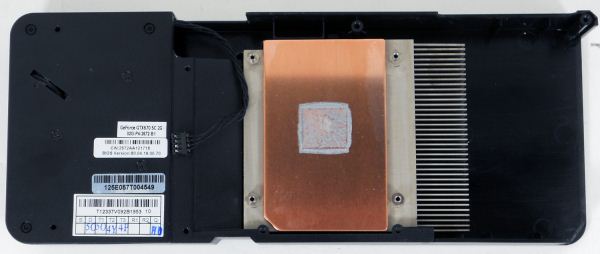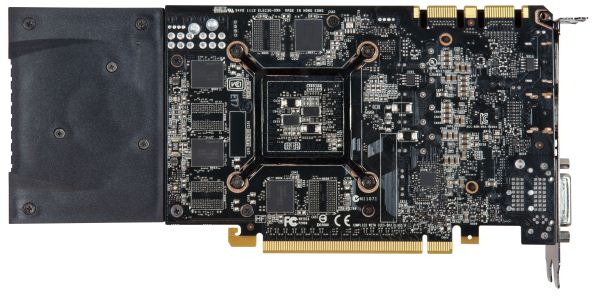NVIDIA GeForce GTX 670 Review Feat. EVGA: Bringing GK104 Down To $400
by Ryan Smith on May 10, 2012 9:00 AM ESTMeet The GeForce GTX 670
Because of the relatively low power consumption of GK104 relative to past high-end NVIDIA GPUs, NVIDIA has developed a penchant for small cards. While the GTX 680 was a rather standard 10” long, NVIDIA also managed to cram the GTX 690 into the same amount of space. Meanwhile the GTX 670 takes this to a whole new level.
We’ll start at the back as this is really where NVIDIA’s fascination with small size makes itself apparent. The complete card is 9.5” long, however the actual PCB is far shorter at only 6.75” long, 3.25” shorter than the GTX 680’s PCB. In fact it would be fair to say that rather than strapping a cooler onto a card, NVIDIA strapped a card onto a cooler. NVIDIA has certainly done short PCBs before – such as with one of the latest GTX 560 Ti designs – but never on a GTX x70 part before. But given the similarities between GK104 and GF114, this isn’t wholly surprising, if not to be expected.
In any case this odd pairing of a small PCB with a large cooler is no accident. With a TDP of only 170W NVIDIA doesn’t necessarily need a huge PCB, but because they wanted a blower for a cooler they needed a large cooler. The positioning of the GPU and various electronic components meant that the only place to put a blower fan was off of the PCB entirely, as the GK104 GPU is already fairly close to the rear of the card. Meanwhile the choice of a blower seems largely driven by the fact that this is an x70 card – NVIDIA did an excellent job with the GTX 560 Ti’s open air cooler, which was designed for the same 170W TDP, so the choice is effectively arbitrary from a technical standpoint (there’s no reason to believe $400 customers are any less likely to have a well-ventilated case than $250 buyers). Accordingly, it will be NVIDIA’s partners that will be stepping in with open air coolers of their own designs.
Starting as always at the top, as we previously mentioned the reference GTX 670 is outfitted with a 9.5” long fully shrouded blower. NVIDIA tells us that the GTX 670 uses the same fan as the GTX 680, and while they’re nearly identical in design, based on our noise tests they’re likely not identical. On that note unlike the GTX 680 the fan is no longer placed high to line up with the exhaust vent, so the GTX 670 is a bit more symmetrical in design than the GTX 680 was.

Note: We dissaembled the virtually identical EVGA card here instead
Lifting the cooler we can see that NVIDIA has gone with a fairly simple design here. The fan vents into a block-style aluminum heatsink with a copper baseplate, providing cooling for the GPU. Elsewhere we’ll see a moderately sized aluminum heatsink clamped down on top of the VRMs towards the front of the card. There is no cooling provided for the GDDR5 RAM.

Note: We dissaembled the virtually identical EVGA card here instead
As for the PCB, as we mentioned previously due to the lower TDP of the GTX 670 NVIDIA has been able to save some space. The VRM circuitry has been moved to the front of the card, leaving the GPU and the RAM towards the rear and allowing NVIDIA to simply omit a fair bit of PCB space. Of course with such small VRM circuitry the reference GTX 670 isn’t built for heavy overclocking – like the other GTX 600 cards NVIDIA isn’t even allowing overvolting on reference GTX 670 PCBs – so it will be up to partners with custom PCBs to enable that kind of functionality. Curiously only 4 of the 8 Hynix R0C GDDR5 RAM chips are on the front side of the PCB; the other 4 are on the rear. We typically only see rear-mounted RAM in cards with 16/24 chips, as 8/12 will easily fit on the same side.
Elsewhere at the top of the card we’ll find the PCIe power sockets and SLI connectors. Since NVIDIA isn’t scrambling to save space like they were with the GTX 680, the GTX 670’s PCIe power sockets are laid out in a traditional side-by-side manner. As for the SLI connectors, since this is a high-end GeForce card NVIDIA provides 2 connectors, allowing for the card to be used in 3-way SLI.
Finally at the front of the card NVIDIA is using the same I/O port configuration and bracket that we first saw with the GTX 680. This means 1 DL-DVI-D port, 1 DL-DVI-I port, 1 full size HDMI 1.4 port, and 1 full size DisplayPort 1.2. This also means the GTX 670 follows the same rules as the GTX 680 when it comes to being able to idle with multiple monitors.
















414 Comments
View All Comments
CeriseCogburn - Friday, May 11, 2012 - link
Wasn't caught ? LOL Sounds correct, at least in your mind.Problem is when amd is caught red handed, none of you amd fanboys have a clue about it, ever.
Now I don't have anything against AMD, it's just clear the truth should be told, as I said let's apply the amd fanboy talking points equally, let's do a real analysis and not with instant amnesia that favors amd or ignores the current facts like egg sales.
I have noticed you amd fans have a real hatred for nVidia and all say a similar thing as you just did. It's like poor loser syndrome but I don't think any of you are faking it, I think you are living it in your minds.
That's really sad.
I do believe that's why you can so blindly deny facts and are so often excuse makers and liars for amd and against nVidia quite unfairly. Cut out the hate man. nVidia isn't somehow worse than amd, nor vise versa.
Now I assure you, my post you went into attack mode over above is very simply my on the fly instant analysis by assembling the known facts. It includes principles like what's good for the goose is also fair on the gander, and very simple logic, and some actual original thoughts, etc.
My apologies that I am so excessively astute and can easily see though the amd fud monkey tp, and worse yet, right, show easily the actual nVidia advantage in that very area.
I'm gifted.
SlyNine - Saturday, May 12, 2012 - link
The GTX680 has out sold the 78xx line, interesting, but you need to prove it.CeriseCogburn - Saturday, May 12, 2012 - link
Go to new egg and click on the best selling EVGA GTX680, go to the reviews tab, click the verified buys checkmark, and read the number of verified buyers of the total commenters.That gives you a fair estimate that will be about the same as fair estimates for other products ( it eliminates counting spammers who just have to post without purchasing ).
So just go do that also for the 7870 and 7850 and add up all the totals, and of course include on the 7870 and 7850 and out of stock cards, the "up to 5 eggs" reviews are available for out of stock...
Compare your totals, if you don't know how to navigate new egg efficiently the tip you need is use the "Guided Results" tab on the upper left area once you have clicked into "Desktop Graphics Hardware" from the "shop all stores" yellow upper left start button.
So anyway, 680 was 108 verified a few days ago and all the 7870 and 7850 combined in total were below that by like 30 something - only a single 680 sku was needed, making it easier to collate in the nVidia side.
It should take you all of 3 minutes to verify this right now, and given the level of competence in this post area, here's some helpful starts
http://www.newegg.com/Product/Product.aspx?Item=N8...
680 single sku up to 111 now up from 108
78xx series link access below
http://www.newegg.com/Product/ProductList.aspx?Sub...
There you are, the proof you demanded, once again delivered.
SlyNine - Saturday, May 12, 2012 - link
So that's you're premise for total sales, how many verified buyers there are on neweggs REVIEWS. That's one hella questionable premise and invalid inference of the data available.lmao. Epic fail. Take a logic class
CeriseCogburn - Sunday, May 13, 2012 - link
Yes whine about the data set all you want, but we also have reviewer commentary that is confirming in this, with zero counters by you and yours.Newegg is actually quite an accurate machine for such a thing, best price, best known, most used, and has shown accuracy for a long time in this manner.
Foreigners (non USA) may argue but we don't see any counter arguments now do we mr sad 5870 ? :)
MrSpadge - Thursday, May 10, 2012 - link
You should compare to HD7950 or HD7970 instead of HD6970.. otherwise it's a no brainer ;)chizow - Thursday, May 10, 2012 - link
Certainly a better effort from Nvidia but the premiums are still a product of AMD's overpriced 28nm parts.If AMD priced as they should've from the outset based on historical pricing and relative performance to 40nm parts, we would've seen:
7970 @ $380
7950 @ $300
and Nvidia's parts would've fallen into place accordingly as well:
680 @ $400-$420
670 @ $350
GK110/685 @ $500-$550
GTX 690 @ $700-800
I guess we can't fault Nvidia too much though. In the end they can't keep GK104 in stock anywhere and they still manage to beat AMD convincingly in both price and performance.
The consumer is the one that loses however, paying high premiums for the smallest increase in performance for a full generational/process node improvement.
XZerg - Thursday, May 10, 2012 - link
The price gauging is always a product when the underdog in a market (not necessarily in performance) outdoes the big boss. We saw this happen back when AMD brought out the A64 as well or when ATI released R300 chip. So from consumer's $$$ point of view underdog should stay underdog but deliver performance that matches the big boss.JlHADJOE - Thursday, May 10, 2012 - link
G92 baby!90% of 8800GTX performance at less than half the price.
It was so good, it actually stayed competitive through 3 or 4 product cycles (albeit getting a new sticker every time).
CeriseCogburn - Thursday, May 10, 2012 - link
That's a failed analysis since the price gouging by the same complainers is always present on the flagship models.The true analysis is the honest and common sense one. No matter what anyone's twisted brain calls the competers, when any one in competition throws up a leader board item, they charge for it.
What's shameful in amd's case is the very quick slap down they experienced - smacking $579.99 down to $449.99(or 479) then the second whallop sending them to the deck, the 3 games they offered to attempt to keep interest going, and now another knockout punch square to the drooling amd choppers as they wobbled on noodle legs still getting the former ten count - the GTX670 tag team card with the new smack down....
I suspect amd will try to maintain some sort of composure and self esteem this time by not budging as long as they possibly can... because it's embarrassing already and now the GTX670 has turned amd from bright pink to their standard red color - flush to the point of passing out.
Yes, amd will pretend now - pretend it doesn't have to drop prices again.